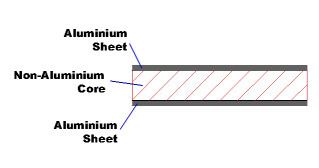 | ||
A sandwich panel is a structure made of three layers: low density core inserted in between two relatively thin skin layers. This sandwich setup allows to achieve excellent mechanical performance at minimal weight. The very high rigidity of a sandwich panel is achieved thanks to interaction of its components under flexural load applied to the panel: core takes the shear loads and creates a distance between the skins which take the in-plane stresses, one skin in tension, the other in compression. General information on sandwich panel structure, different sandwich core types available and the potential with respect to weight savings is available in the following reference.
Contents
Honeycomb sandwich panel has been proven as the most efficient sandwich design with respect to mechanical performance and weight. Aerospace and aircraft industry uses the honeycomb structures as they meet the tough requirements of related applications. The use of honeycomb sandwich design in more common applications has been more limited due to the batch wise manufacturing processes and hence relatively high production costs.
This trend has been changed after the company EconCore developed a continuous process of honeycomb production under the brand name ThermHex. Cost efficiency of the ThermHex process, which has been licensed by number of companies over the world, allows a very cost effective production of sandwich panel with thermoplastic honeycomb core for applications in even cost sensitive market segments such as packaging, automotive, or building & construction.
Aluminium composite panel (ACP), also aluminium composite material (ACM), is a type of flat panel that consists of two thin aluminium sheets bonded to a non-aluminium core. ACPs are frequently used for external cladding or facades of buildings, insulation, and signage. If the core material is flammable, usage may be problematic as a building material and some jurisdictions have banned their use.
Aluminium sheets can be coated with polyvinylidene fluoride (PVDF), fluoropolymer resins (FEVE), or polyester paint. Aluminium can be painted in any kind of colour, and ACPs are produced in a wide range of metallic and non-metallic colours as well as patterns that imitate other materials, such as wood or marble. The core is commonly low-density polyethylene, or a mix of low-density polyethylene and mineral material to exhibit fire retardant properties.
3A Composites (formerly Alcan Composites & Alusuisse) invented aluminium composites in 1964 and commercial production of Alucobond commenced in 1969, followed by Dibond 20 years later.
Design
J. M. Davies, Mohammed Rahif Hakmi, and P. Hassinen conducted a series of early researches into numerical, experimental behavior of materials and fire and blast behavior of composite material. They published multiple research articles on the following subjects:
Applications
Sandwich panels are used in applications where high structural rigidity and low weight are required. An evident example of use of sandwich panels is aircraft, where mechanical performance and weight saving is essential. Other applications include packaging (e.g. fluted polypropylene boards of polypropylene honeycomb boards), transportation and automotive as well as building & construction.
ACP is mainly used for external and internal architectural cladding or partitions, false ceilings, signage, machine coverings, container construction, etc. Applications of ACP are not limited to external building cladding, but can also be used in any form of cladding such as partitions, false ceilings, etc. ACP is also widely used within the signage industry as an alternative to heavier, more expensive substrates.
ACP has been used as a light-weight but very sturdy material in construction, particularly for transient structures like trade show booths and similar temporary elements. It has recently also been adopted as a backing material for mounting fine art photography, often with an acrylic finish using processes like Diasec or other face-mounting techniques. ACP material has been used in famous structures as Spaceship Earth, VanDusen Botanical Garden, the Leipzig branch of the German National Library.
These structures made optimal use of ACP through its cost, durability, and efficiency. Its flexibility, low weight, and easy forming and processing allow for innovative design with increased rigidity and durability.
